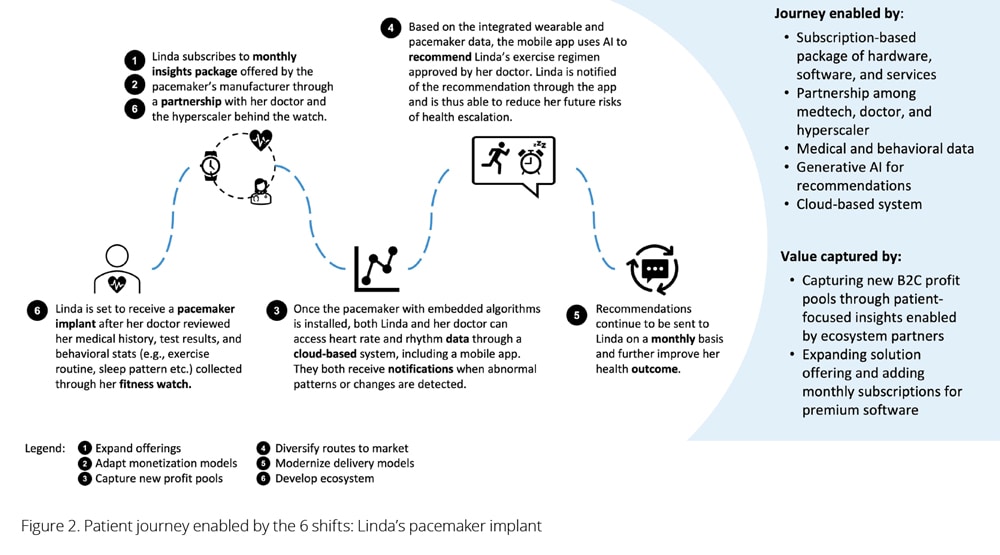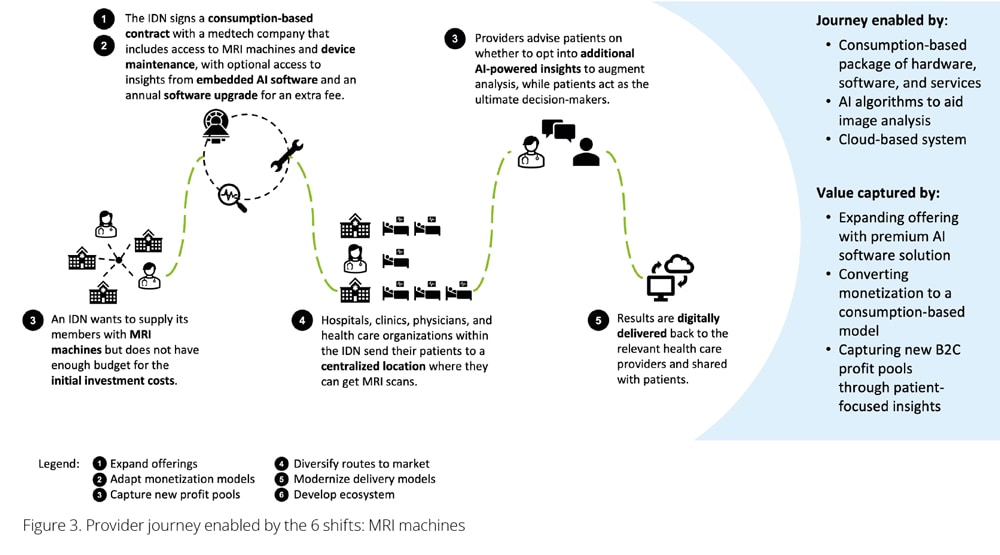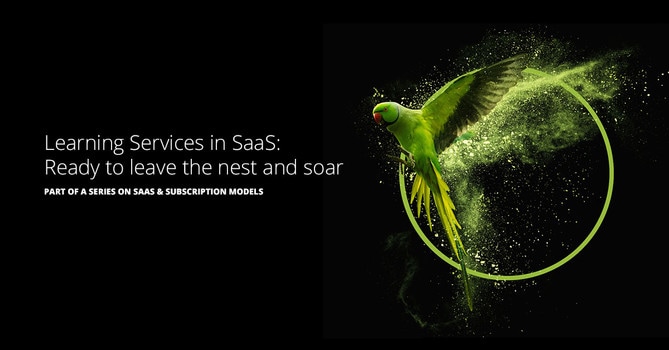Medtech services: Beyond the device has been saved

Perspectives
Medtech services: Beyond the device
Everything-as-a-Service perspectives in health care
Rapid shifts in health care are triggering new customer demands and expectations. For medical technology (medtech) companies seeking to remain competitive and continue to deliver value to patients and care providers, Everything-as-a-Service (XaaS) models offer a compelling way to “go beyond the device” to reach profitability.
Disruptive trends and the need to go beyond the device
Medtech is poised to empower health care providers to advance their clinical capabilities and improve patient care and services by leveraging next-generation solutions such as robotics, artificial intelligence (AI), and 3D printing. However, this traditionally hardware-centric industry is ripe for disruption.
To thrive in today’s increasingly dynamic market, medtech companies need to explore new solution and services-based approaches to deliver greater value to customers—value that goes “beyond the device.”
The convergence of macro trends—including digitization, cost pressures, regulations, and patient-centric care (figure 1)—is shaping the case for change in medtech.

The emergence of new patient and provider needs
In response to these macro trends, patients and providers have evolved their health care expectations and desired experiences. In fact, 84% of patients believe that preventive care and wellness should be the primary focus of their provider.1 The new “engaged patient” takes a more active role in their health care journey and, as such, is increasingly willing to pay for premium health solutions and services tailored to their prevention and wellness preferences over treatment. Patients are also demanding customized and convenient care adapted to personal behaviors and routines, with greater ownership of their secure health data. This engaged patient persona creates a new market segment of active consumers with distinct health demands and a willingness to pay for solutions that meet their specific needs.
Meanwhile, health care providers are thinking beyond the device as they seek margin improvement and budget optimization. In the face of mounting margin and cost management pressures, providers are seeking to shift from capital expenses (CapEx) to operating expenses (OpEx) for increased flexibility. Moving from a product-centric to a service-centric model helps providers create data-enabled, end-to-end care experiences for patients—driving superior economic and health outcomes. As a result, providers look to offer data-rich health care services and software on top of next-gen medical devices to deliver tailored, value-based solutions to patients. Seventy-five percent of providers state that access to patient data and analytic tools is critical to delivering quality, value-based care.2
Amid the rise of more engaged consumers and shifting provider priorities, the time for medtech companies to change is now. To capitalize on these changes, medtech players need to embrace a more holistic view of the patient care journey beyond the physical device.
Six ways to keep medtech services relevant and thriving
We propose six decisive shifts medtech leaders should consider as they seek to address evolving patient and provider needs:
- Expand offerings. Provide integrated, end-to-end medtech services and software to augment feature-oriented hardware, equipment, and consumables that boost provider efficiency and improve patient quality of care. Service-centric offerings may also help medtech players build lasting relationships with providers through increased customer stickiness.
- Adapt monetization models. Instead of one-time, upfront CapEx sales and leasing contracts, medtech companies should consider transitioning to recurring payments via cost-effective OpEx subscription, consumption, and outcome-based solutions that enable providers to manage rising infrastructure and equipment costs.
- Capture new profit pools. Tailor offerings to the needs of consumers willing to pay for higher-end solutions that meet their specific health needs—expanding beyond traditional business-to-business (B2B) customers (that is, hospitals, clinics, physicians, and insurance providers). This new business-to-consumer (B2C) segment provides an opportunity to diversify revenue streams and tap into a broader consumer ecosystem of high-margin premium software solutions and consumer technology.
- Diversify routes to market. Increase points of customer interaction by deploying a consistent omnichannel care delivery approach, and leverage brand strengths by partnering with vendors with complementary offerings. Augment traditional B2B markets by expanding to self-service e-commerce for B2C customers to enhance buying experiences and streamline sales.
- Modernize delivery models. Leverage cloud services to enhance scalability, automation, and real-time integration. Use a private-public cloud hybrid model to host personally identifiable information (PII) and operational data, depending on specific business requirements around costs, capacity, and data security.
- Develop an ecosystem. Foster partnerships with disrupters to proactively shape an ecosystem that connects “beyond the walls” care solutions across the patient health journey versus ad hoc, point-of-intervention offerings within traditional sites of care. As patients become active consumers, such partnerships can enable medtech companies to incorporate behavioral science insights into their services to effectively address the needs of the emerging B2C market segment.

These shifts enable a reimagined patient journey (figure 2) that empowers medtech organizations to deliver superior health and economic outcomes. This is also fueled by digitalization and patient-centricity macro trends that unlock new patient data, ecosystem partner opportunities, etc.—which can be monetized and delivered through innovative models to capture new B2C profit pools.
Furthermore, these shifts extend beyond the patient journey and inspire a reimagined provider journey as well (figure 3). With increasing digitization and cloud-based systems, medtech companies can harness the potential of their data and advanced algorithm software solutions through integrated offerings while providing the flexibility that providers need.

Enter Everything-as-a-Service in medtech
Everything-as-a-Service (XaaS) refers to the bundling of products (such as hardware, devices, equipment, consumables) and/or software with value-added services. XaaS employs recurring payment structures with either a fixed subscription fee or a flexible consumption model where the fee is adjustable by usage level or outcome. This departs from legacy product-only offerings that have one-time, upfront capital expenditures as a hallmark. Through the adoption of XaaS, medtech organizations can effectively navigate dynamic industry shifts and evolving provider and patient needs. Further, these players can leverage the unique advantages of XaaS in the following ways:
- New profit pools: Value-added services and integrated solutions unlock new “beyond the device” profit pools and revenue streams targeted to both B2B and B2C customers, expanding market penetration.
- XaaS in action: One medtech leader in orthopedic products and solutions offers patients a digital care management platform through a mobile application software subscription in addition to its B2C offerings.
- XaaS in action: One medtech leader in orthopedic products and solutions offers patients a digital care management platform through a mobile application software subscription in addition to its B2C offerings.
- Predictable revenue and improved margins: By shifting from significant upfront investment outlays to recurring fee payments, medtech companies have a more financially predictable option with improved margins.
- XaaS in action: One prominent medtech orthopedic specializing in sports medicine surgical products and services offers rent-to-own financing solutions to alleviate capital burden on customers and have more consistent revenue.
- XaaS in action: One prominent medtech orthopedic specializing in sports medicine surgical products and services offers rent-to-own financing solutions to alleviate capital burden on customers and have more consistent revenue.
- Enhanced offerings: By partnering with innovative ecosystem players such as hyperscalers, medtech companies can create additional revenue streams from nontraditional services such as behavioral science analysis and insights.
- XaaS in action: One prominent continuous glucose monitoring (CGM) leader has collaborated with consumer technology hyperscalers, enabling diabetes patients to monitor their glucose levels using the hyperscalers’ hardware and software prowess.
- XaaS in action: One prominent continuous glucose monitoring (CGM) leader has collaborated with consumer technology hyperscalers, enabling diabetes patients to monitor their glucose levels using the hyperscalers’ hardware and software prowess.
- Maximized customer lifetime value: Due to the recurring revenue nature of XaaS, medtech companies can extend their interactions with customers as they continuously use services and solutions, thereby maximizing customer lifetime value.
- XaaS in action: One leading provider of laboratory instruments, software, services, and consumables offers a comprehensive monthly subscription package for selected instruments. This strategic shift away from isolated one-off purchases has increased customer engagement and opportunities for upsell/cross-sell for this medtech leader.
- XaaS in action: One leading provider of laboratory instruments, software, services, and consumables offers a comprehensive monthly subscription package for selected instruments. This strategic shift away from isolated one-off purchases has increased customer engagement and opportunities for upsell/cross-sell for this medtech leader.
- Data-enabled, value-based care: As XaaS allows care providers to offload the burden of asset management and focus on delivering high-quality patient care, medtech providers can bridge the gap and capture service-based revenue streams for instrument monitoring and repair.
- XaaS in action: One global provider of research services, instruments, consumables, and software solutions offers a connected asset performance software solution to detect instrument health issues before they occur by leveraging predictive analytics.
- XaaS in action: One global provider of research services, instruments, consumables, and software solutions offers a connected asset performance software solution to detect instrument health issues before they occur by leveraging predictive analytics.
The time to transition and reap the benefits of XaaS has arrived—Deloitte’s analysis of 24 leading medtech companies’ products, value-added services, and monetization models found that several medtech leaders are already adopting XaaS business models to seize emerging market opportunities.3 Although much of the industry is still at an early stage in their XaaS journey, most leading companies have already introduced software offerings, with 80% of them monetizing their products through subscription-based models.4 Additionally, 16 of the 24 leading medtech players offer advanced value-added services.5
As many leading organizations have already adopted aspects of XaaS, it is essentially a race to the finish line: Companies that get their XaaS transformation right will position themselves as the enduring market leaders shaping the future of health care. Those that don’t embrace the shift risk falling behind.

Take your medtech services further with XaaS
Learn what it takes to start your transformation journey.
Get in touch
Contributors
Ayo Odusote
Tarun Desai
Mukund Gourishankar
Welton Li
Vy Nguyen
Lucas Woo
Madeline Mauboussin
Endnotes
1 Christine Cohidon et al., “Patients’ and general practitioners’ views about preventive care in family medicine in Switzerland: A cross-sectional study,” Journal of Preventive Medicine and Public Health 52, no. 5 (2019): pp. 323–32.
2 Michael S. Barr, Rick A. Moore, and Mike Noshay, “Clinical data usability: A critical step in the shift to value-based care,” Healthcare Information and Management Systems Society, March 9, 2023.
3 Deloitte research.
4 Ibid.
5 Ibid.
Recommendations
Customer Success Strategy
A customer-first approach for succeeding in the XaaS world





